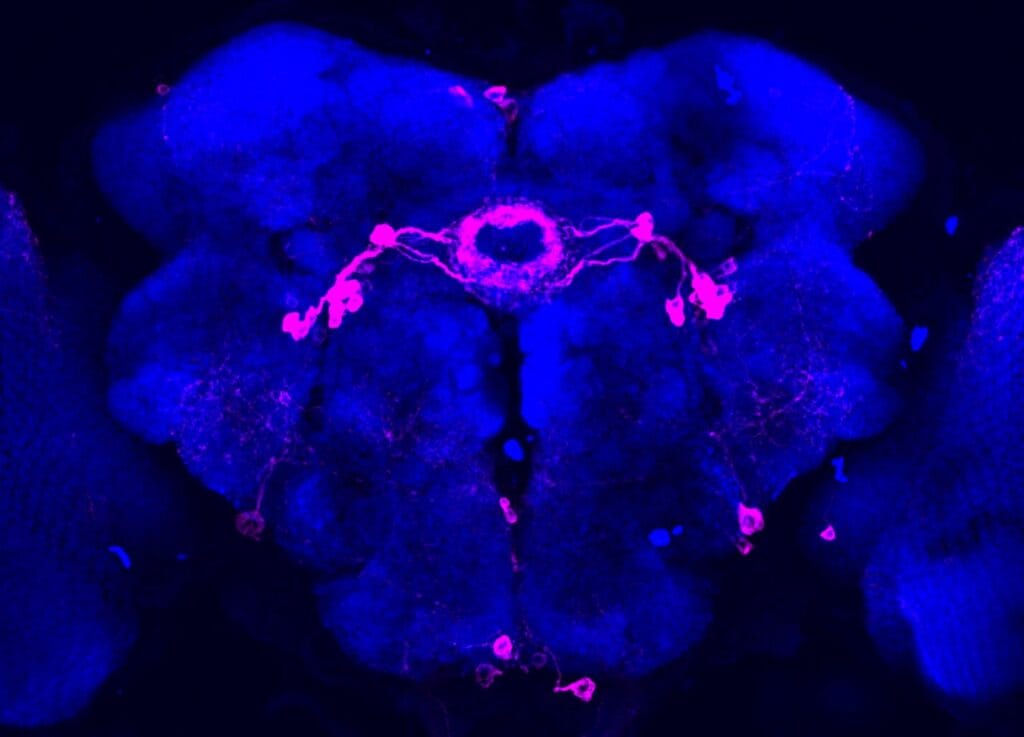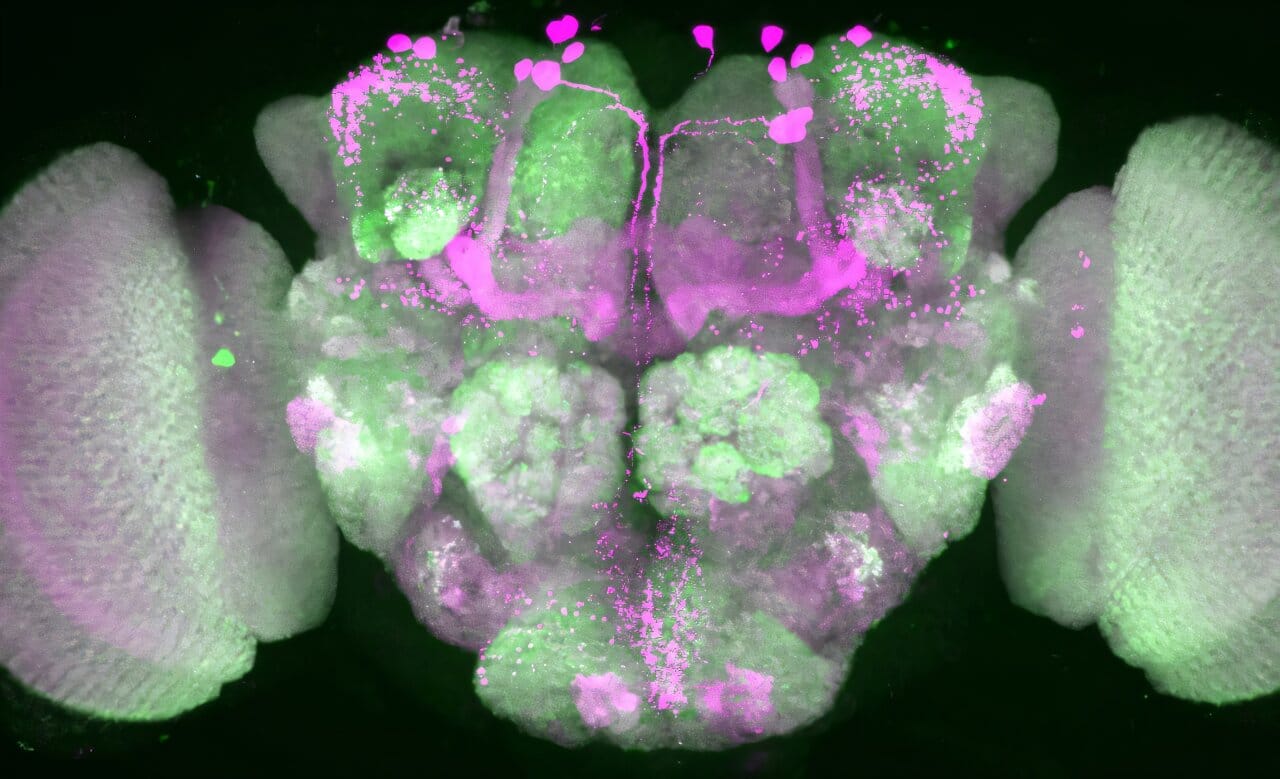Every living creature, from humans to the tiniest insect, needs sleep. It is one of the great common denominators of life. Yet, sleep is puzzling. Why should any animal, in a world full of dangers, choose to spend long hours in a vulnerable state? For us, sleep brings physical recovery, mental clarity, and memory consolidation. But what about something as small and fragile as a fruit fly?
Researchers at Charité–Universitätsmedizin Berlin have uncovered fascinating answers. In a recent study published in Nature, they revealed how the brain of a fruit fly manages the delicate balance between rest and alertness. This work doesn’t just illuminate the biology of insects—it also provides intriguing hints about how human sleep might operate.
A Window Half-Open
For an animal to survive, it cannot afford to completely switch off from the world around it. A sleeping fly, like a sleeping human, must remain ready to react to danger. The Charité team discovered that flies achieve this balance through a clever mechanism in the brain.
Prof. David Owald, who led the study, describes it as a kind of filter. The fly’s brain doesn’t shut down entirely during sleep; instead, it rhythmically blocks most incoming visual signals, while still allowing very strong ones to slip through.
The researchers compare it to leaving a window slightly open. The room is shielded from outside drafts, yet if a strong gust of wind blows, it will push the window open. In the same way, only intense visual cues can penetrate the fly’s brain filter during sleep, triggering an awakening.
The Dance of Brain Waves
So how does the fly’s brain create this filter? The secret lies in two networks of neurons that work in opposition. One network excites and responds to visual information, while the other suppresses it. During wakefulness, the activating network dominates, allowing the fly to react swiftly to moving shadows or flickers of light. But as night falls and the fly grows drowsy, the inhibitory network rises to the forefront, dampening responses to external stimuli.

Dr. Davide Raccuglia, first author of the study, explains that when both networks are active together, inhibition usually wins. This allows the fly to gradually phase out its surroundings and drift into rest.
Yet, this state is not static. The fly’s brain generates slow, rhythmic electrical waves—one per second—that ebb and flow across these networks. When the voltage is low, incoming signals are easily blocked. But when the voltage rises, there is a brief opening, a fleeting chance for strong visual stimuli to break through.
In those moments, a flash of light or sudden movement can snap the fly out of its slumber.
Sleep With One Eye Open
The beauty of this system is its balance. The fly gets the restorative benefits of sleep, without becoming dangerously oblivious to its environment. It is, in essence, sleeping with one eye open.
Dr. Raquel Suaréz-Grimalt, co-first author of the study, explains that these rhythmic openings are crucial. Without them, the animal would be too detached from the outside world and at risk of missing threats. With them, however, survival becomes possible—even during rest.
This elegant dance of inhibition and activation underscores the evolutionary importance of sleep. It is not merely about shutting down, but about carefully managing sensitivity to the world.
Lessons for Humans
Of course, the natural question is whether humans operate in the same way. Our brains are vastly more complex, yet they too rely on slow-wave activity during sleep. In fact, slow-wave sleep is considered one of the most important stages for recovery and memory.
In humans, a brain structure called the thalamus plays a role similar to the fly’s filtering networks. It acts as a gatekeeper for sensory information, shaping the rhythms that characterize deep sleep. Like the flies, our brains must walk a tightrope: filtering out most distractions so that we can rest, while still allowing intense stimuli—like a baby’s cry or a loud noise—to break through.
Prof. Owald suggests that what the team found in fruit flies might be a universal principle. Across evolution, from insects to humans, brains may have developed similar strategies for protecting the vital state of sleep while maintaining a lifeline to the external world.
Why This Matters
At first glance, studying how a tiny insect sleeps might seem trivial. But flies, with their small and accessible nervous systems, offer powerful insights into how brains work in general. By decoding the rhythms of a fly’s sleep, researchers are inching closer to solving one of biology’s greatest mysteries: why sleep exists and how it is regulated.
The implications go beyond curiosity. Sleep disorders, insomnia, and disturbances in deep sleep are pressing health issues for millions of people worldwide. Understanding the underlying mechanisms could one day lead to better treatments—not only for sleep problems but also for memory-related conditions such as Alzheimer’s disease.
The Silent Symphony of Sleep
What emerges from this study is a picture of sleep not as passive rest, but as an active, finely tuned process. In the fruit fly’s brain, activating and inhibitory networks engage in a constant, rhythmic dialogue. Their dance allows the insect to rest and yet remain connected to the world, poised to awaken if danger arrives.
For us, it is a reminder that sleep is not simply about closing our eyes. It is a state of delicate balance, a biological symphony that plays out in waves and rhythms, shaped by evolution to protect us as we restore ourselves.
Even in the fragile brain of a fly, sleep reveals itself as both a necessity and a marvel—a testament to the fact that life, in all its forms, must pause, regenerate, and yet never completely let down its guard.
More information: Davide Raccuglia et al, Network synchrony creates neural filters promoting quiescence in Drosophila, Nature (2025). DOI: 10.1038/s41586-025-09376-2






